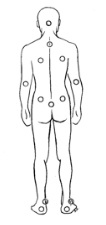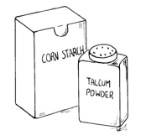Bedsore Causes, Prevention and Treatments
Back to the Table of Contents
 If you have to lie immobile for long periods of time, you should pay special attention to the health of your skin, to prevent skin breakdown. Proper skin care helps to prevent pressure sores (bedsores) and will help you feel generally refreshed. Weight loss and the side effects of radiation or chemotherapy can lower your resistance to infections; and since infections can be very difficult to treat, the best thing is to prevent them. Skin is your body's first line of defense against infection, and a rupture of the skin exposes you to infections. Germs can enter the body through a cut, an open bedsore, or raw, chafed skin.
If you have to lie immobile for long periods of time, you should pay special attention to the health of your skin, to prevent skin breakdown. Proper skin care helps to prevent pressure sores (bedsores) and will help you feel generally refreshed. Weight loss and the side effects of radiation or chemotherapy can lower your resistance to infections; and since infections can be very difficult to treat, the best thing is to prevent them. Skin is your body's first line of defense against infection, and a rupture of the skin exposes you to infections. Germs can enter the body through a cut, an open bedsore, or raw, chafed skin.
Causes
Bedsores are caused when an area of skin loses its blood supply for an extended period of time, e.g., when a bony area of the body lies against a surface like a mattress, and nutrients and oxygen are unable to reach the skin cells. The area begins to break down and the skin cells eventually die. Parts of your body which are particularly susceptible are the coccyx or tailbone, the hip bones, the spine, elbows, heels and ankles, and the shoulder blades.
If redness doesn't go away from these bony areas a short time after the pressure is removed, the skin is probably not receiving adequate bloodflow.
Prevention
You can prevent bedsores by changing your position frequently, at least every two hours. In addition, cushioning the bony parts of your body is a good way to reduce pressure on the skin. An egg crate mattress, or a foam or sheepskin pad will cushion you, as well as providing better air circulation for the skin. Use pillows or any other props which help to reduce pressure on those areas.
Treatment
Heat and massage are additional means of increasing the blood supply to the skin. Whirlpool baths are ideal for this purpose. Although heat lamps or heating pads can also be used, you must take care not to burn your skin, which is already tender. First check with your doctor or nurse to make sure a lamp or heating pad would be helpful to you; and if you do use a pad, keep it turned on low, and keep a protective pad or towel between it and your body to avoid skin burns. Warm socks, an extra blanket at the foot of the bed, or fleece-lined booties are often more helpful than heating appliances. (See: Massage Therapy Techniques that will also increase bloodflow to your skin.)
Preventative Tips for Maintaining Healthy Skin
Back to the Table of Contents
Good hygiene is the most important part of skin care. If you can, take a daily bath or shower. Even if you are not confined to bed, bathing may be a chore because of the difficulty of climbing in and out of tubs and showers. Try sponging yourself at the sink while sitting in a chair. Aids such as bath seats, grab bars, and long-nozzled showerheads make tub or shower bathing much easier.
If you are confined to your bed, take a daily sponge bath. Ask your family to assist you with the areas which you cannot reach by yourself. There is no one right way to give a bedbath. Common sense will dictate the most comfortable and thorough method for you.
Don't forget bath oils if your skin tends to dryness. Massaging body areas with a little lotion after a bath stimulates circulation and prevents skin breakdown.

Chafing and Irritation
Chafed or irritated skin is caused by a combination of heat, moisture and friction. It occurs most often where skin folds over itself as in the groin area, under the breasts, or in the abdominal area of heavier people. For chafed skin, you want to keep the area clean and dry. A small amount of talcum powder or cornstarch applied after bathing will help keep the area dry and free of bacteria. Exposing chafed skin to the air for a few minutes twice a day will also help keep it dry.
|

 If you have to lie immobile for long periods of time, you should pay special attention to the health of your skin, to prevent skin breakdown. Proper skin care helps to prevent pressure sores (bedsores) and will help you feel generally refreshed. Weight loss and the side effects of radiation or chemotherapy can lower your resistance to infections; and since infections can be very difficult to treat, the best thing is to prevent them. Skin is your body's first line of defense against infection, and a rupture of the skin exposes you to infections. Germs can enter the body through a cut, an open bedsore, or raw, chafed skin.
If you have to lie immobile for long periods of time, you should pay special attention to the health of your skin, to prevent skin breakdown. Proper skin care helps to prevent pressure sores (bedsores) and will help you feel generally refreshed. Weight loss and the side effects of radiation or chemotherapy can lower your resistance to infections; and since infections can be very difficult to treat, the best thing is to prevent them. Skin is your body's first line of defense against infection, and a rupture of the skin exposes you to infections. Germs can enter the body through a cut, an open bedsore, or raw, chafed skin.
